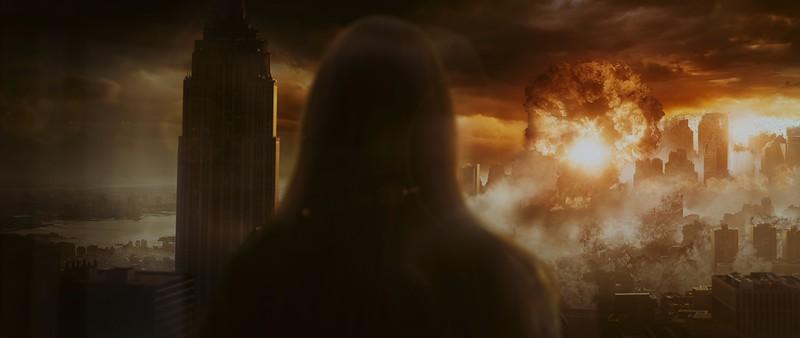
The Divide (Movie Review)
To say apocalypse and post-apocalypse films are one of the spiciest sub-genres of the day may be more than a little obvious. And indeed it is an interesting, complex question many of these types of films ask us to consider. How does the world end for the only species on it that has so much at stake emotionally and psychologically? At their most basic, many North American and European versions of these films seek to reveal what truly lies under our social veneer when resource scarcity, widespread war, and/or climate change are no longer topics flippantly mentioned in news media but create a new reality out of a social structure that once seemed untouchable.
Xavier Gens’s film “The Divide” (written by Karl Mueller and Eron Sheean) is one of most recent entries into this territory. The film immediately opens on a nuclear bombing of New York City that sends a group of tenants and their salty, tough-as-nails super, Mickey (Michael Biehn, yes, THAT Michael Biehn) into an improvised fallout shelter in the building’s basement. Included in the group is the closest thing to our central protagonist Eva (Lauren German), her boyfriend Sam (Iván González), Delvin (Courtney B. Vance), Josh and his brother Adrien (Milo Ventimiglia and Ashton Holmes), Josh’s friend Bobby (Michael Eklund), and lastly mother Marilyn and daughter Wendi (Abbey Thickson). Following the explosion, the survivors are faced with their new claustrophobic existence—including all the bodily ickiness that comes with it—as they wait for the radioactive dust to clear. Soon it becomes apparent that the events outside the shelter are not quite what the survivors expected and they are soon faced with the fact their harsh residency will be for an even more extended period. As resources dwindle, tempers flair, and despair sets in, the survivors take up new roles, turning on one another and losing their grips on morality and their own sanity.
“The Divide” is a film that asks much of its audience. Without any real central narrative focus, it seems as though Gens and the writers are more interested in exploring some seriously ethereal social conceptions of “Good” and “Evil”. Through the film there are references to biblical stories including the creation story, Adam and Eve (Eva…get it…), Cain and Abel, and even some allusions to Christ’s sacrificial violence as a means for cleansing “sin”. But while these gestures make “The Divide” a curious and, admittedly, more surprising film they feel unfulfilled and a touch hollow once we get to the end credits. The brazen, direct ways in which some of these references are handled undermine what gravitas they might have given the narrative, winking at the audience a bit too hard nearing campishness while still maintaining a seriously grime narrative tone.
What does work quite well about “The Divide” is how the use of these character types works in conjunction with the film’s sensory attributes, creating an intensely affective parable on our own national outlook on resource conservation and commentary on a particular Generation-Y stylish, narcissistic hedonism that seems prevalent in many contemporary representations of youth. And while the film hammers this point home a few too many times, it never feels as though it is becoming overly preachy or didactic. It isn’t a film that is worried about having its characters make reprehensible decisions for their own self-interest. A number of the characters do not stop to take stock of their actions but merely act in a purely instinctual present desire. Nor does the film make attempts at forcing awkward exposition of character histories (well, for the most part). Eva is utilized solely as a framing device or to orient us in relation to what is going on in the shelter. One could argue she is the film’s (uncertain) moral compass. But for the most part our time is divided between characters living in the present severity of their new lives. Rather, the top-notch visual and aural executions, particularly Jean-Pierre Taieb’s score, create an experiential horror film that is less concerned with empathizing with its characters than in our own responses to the choices these character types make. In many ways it’s a film that keeps us at a distance in order for us to contemplate our own reactions to the images onscreen.
It’s often said that one of the best ways to comprehend horror fiction is to understand how a particular work functions as a lens to the given time and place in which it was created. The classic example of this type of thinking is usually the atomic age monster movies that emerge in the 1950s in response to radioactive fallout. In this frame, we can certainly see how the narrative here is a product of a particular time. But why “The Divide” works has less to do with its narrative prowess than in its audacity to ask itself and its audience “so what?”. Why do we care so much about the end of the world when it concludes with…well, nothing at all? I respect the nihilism of the film even though I was wholly depressed by it. And for those reasons I respect this film more than the number score may lead you to believe. However, I cannot help but be reminded of much of this film doesn’t work or will simply not be accepted by a wider audience. And while the it doesn’t quite succeed in its more lofty pursuits it is a darkly pessimistic, grim, and at times blackly humorous outlook of one contemporary U.S. culture.

